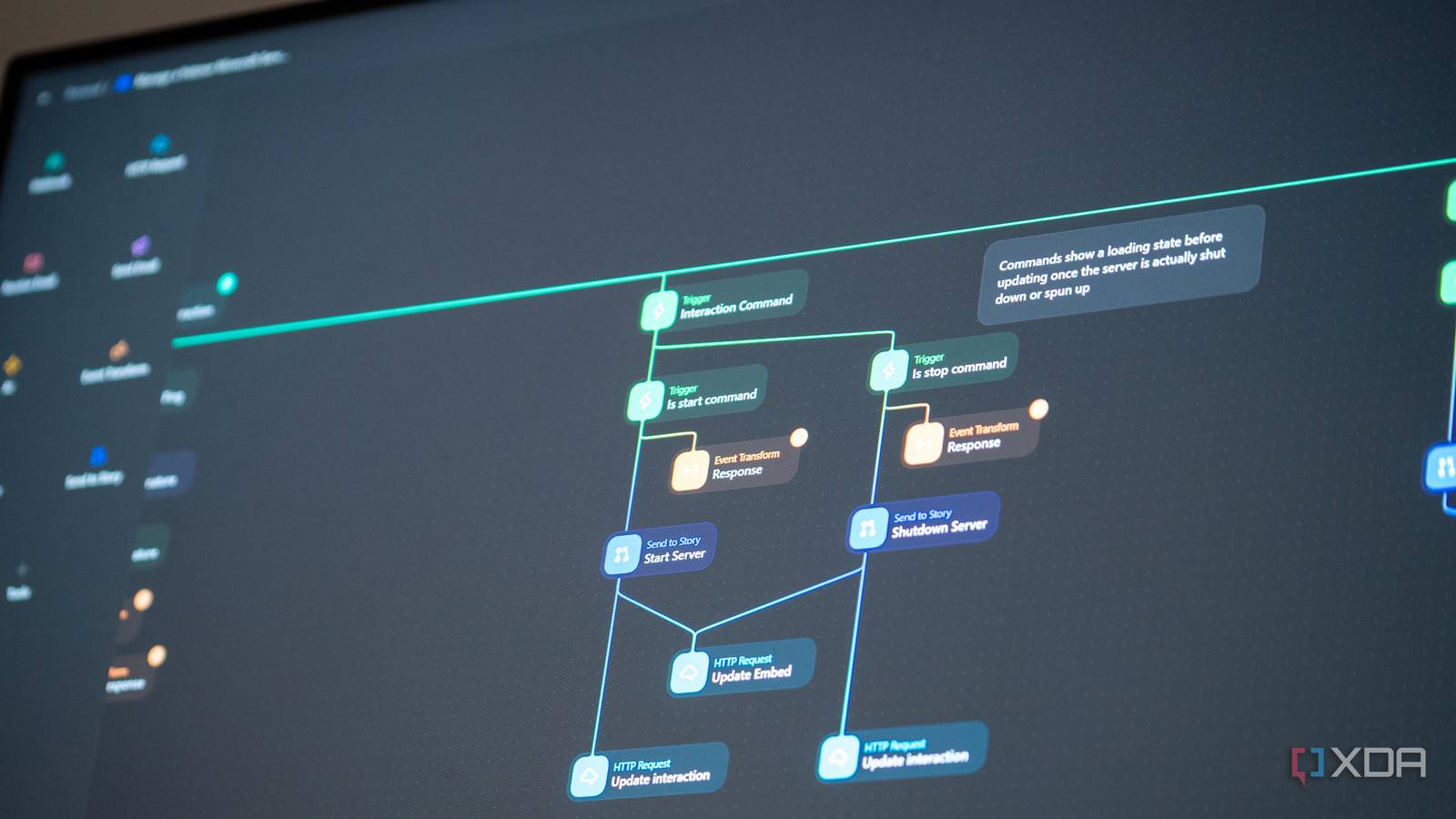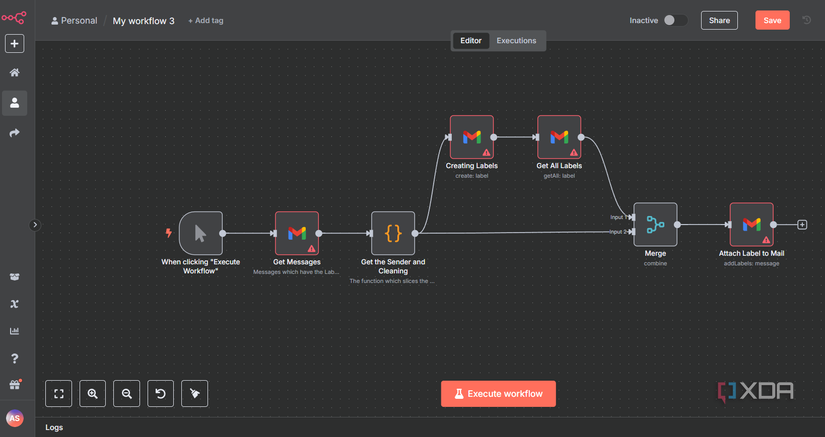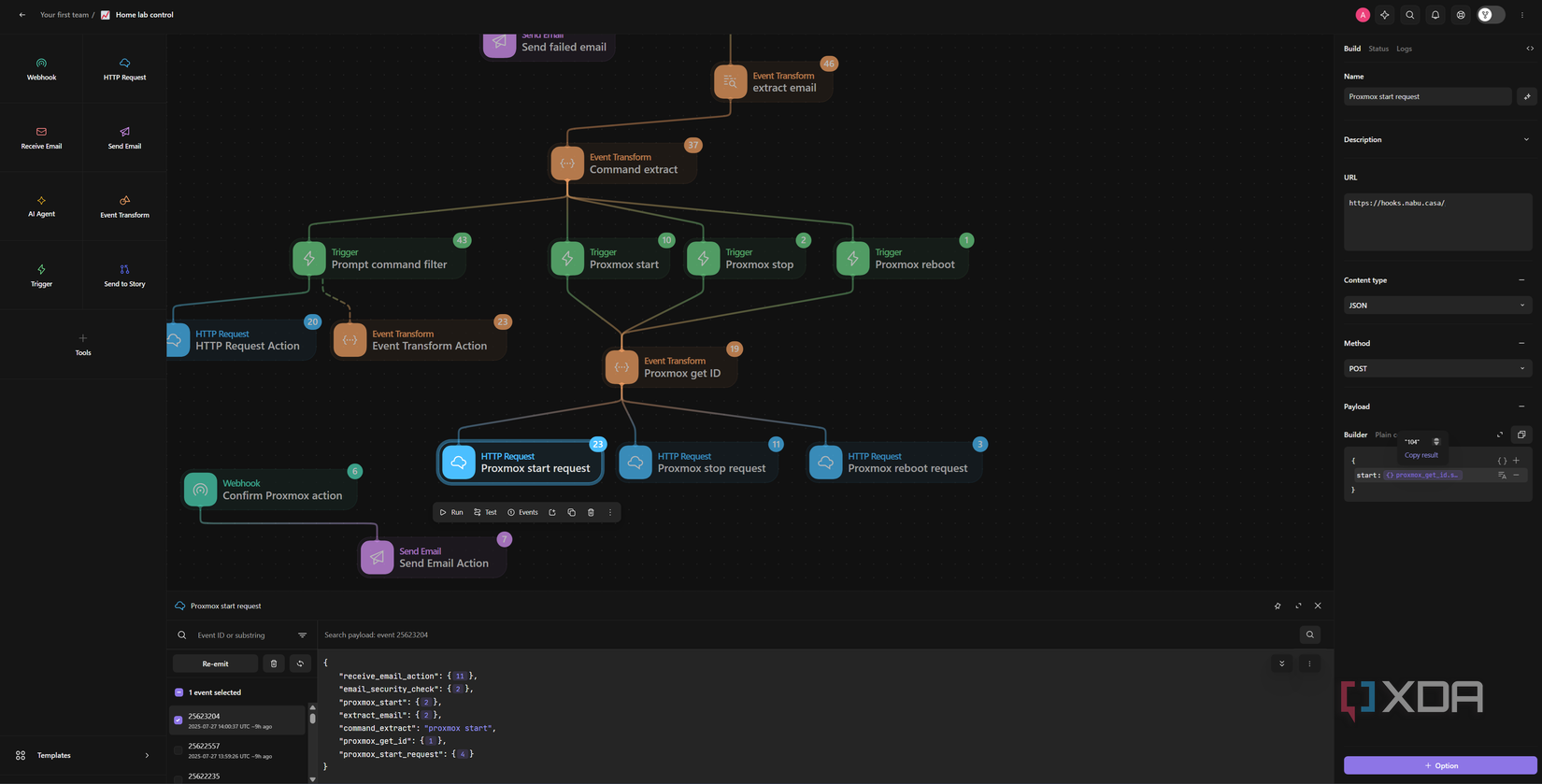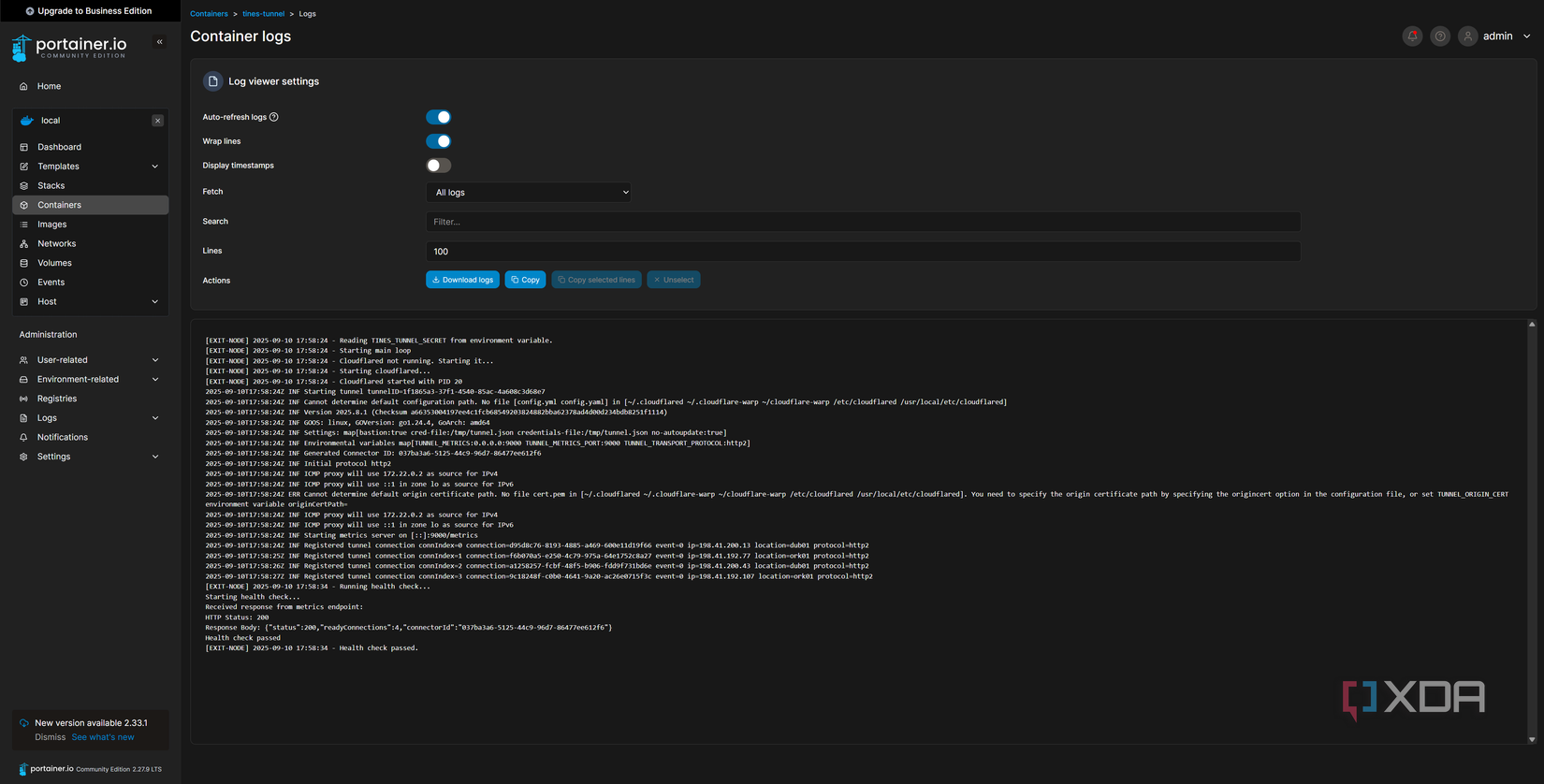
Sign in to your XDA account

There's an entire world of automation out there for those looking to take their home lab a step further, or for fledgling business owners wanting to make their processes more efficient. On one side, n8n is a highly extensible, source-available, node-based workflow engine with a huge catalog and thriving community. On the other, Tines is a security-first orchestration platform built around HTTP-native "stories," auditability, and enterprise controls that security and IT teams tend to care about.
Don't be fooled, though: both are capable of serious, production-grade workloads, but in very different ways with a completely different target audience. In fact, even the act of comparing them in general surfaces those complete differences very quickly.
What are Tines and n8n?
Automation platforms with different goals

When it comes to comparing the two, we need to start with the basics, so we'll examine the free and the paid options available. Both offer free editions that anyone can play with, and those are referred to as the "Community Editions."
n8n's Community Edition is source-available under a Sustainable Use License for internal business usage, and it's not "open-source" in the eyes of the Open Source Initiative. You can still modify it however you'd like, you just can't distribute those changes, and it's fully self-hostable. With that said, to unlock all features in the free edition, it requires a license key that will be emailed free of charge to you once you deploy it and create an account. I've seen some users sharing concerns regarding how the company handles your data.
One such concern originates in the "Data you transmit through the Platform" section of the terms associated with the free self-hosted instance:
All documents, messages, logos, images, files and other information you transmit through our Platform, will remain yours and you shall retain all rights, titles and interest in those. You do however provide us with a worldwide, royalty-free, non-exclusive, transferable and sublicensable right to use your data to improve our Platform.
On that note, other concerns typically relate to the fact that n8n collects quite a lot of data, even from self-hosted users. While it says that it "takes care to keep self-hosted data anonymous," it also says that it collects IP addresses. Users are automatically enrolled in data sharing with n8n, though these can be disabled with environment variables.
Upgrading to a paid self-hosted n8n plan provides features like SSO, insights, version control with Git, and global variables. However, it starts off as a free plan that can be used for business use, which is a pretty big plus for anyone that wants to use it. A self-hosted business option will set you back approximately $9,400 a year at the time of writing.
Moving over to Tines, it's a totally different model. You can't self-host anything relating to Tines on your network without an upgraded account, and the free version includes support for three users, a single team, three flows ("stories"), and 5,000 daily events. SSO is included as a part of the free version, and it's hosted entirely on the Tines platform.
For those who want to give it access to their local network, Tines makes it tough. I basically built a weird tunnel of sorts using Home Assistant and Tines in the past, but there isn't an easy way to do it. You get enterprise-style controls from the get-go, but upgrading isn't really something available even to hobbyists. There's a weird "gap" in what Tines offers; you get a full fledged package of tools available for free, but you jump from a free community edition to a business plan which requires contacting Tines, with no in between.
When I asked Tines about the pricing structure, this is what I was told:
Tines offers a flexible tiered pricing model that meets the maturity of the business's intelligent workflow program. Each license includes a predefined capacity and feature set. All licenses include AI, security essentials, and workflow controls. This packaging approach encourages building and collaboration through generous flow and user capacity. It also allows for predictability in where similar features might fall (i.e. in the team essentials bucket, you can expect anything essential to collaborating across multiple teams will fall there).
There are three editions of Tines:
Community: always free, enables you to start building and validate Tines without any upfront costs
Business: paid plans that grow with you as your intelligent workflows program matures
Enterprise: paid plans that meet the scale of the enterprise usage and required capabilities
Our business and enterprise editions are also available for self-hosted. A customer on the Tines standard business plan typically starts around $170K. For more established programs with more complex needs on the Tines enterprise plan typically starts at $350K. Pricing varies based on desired capacity, add-on products, and professional services.
For detailed pricing information and plan specifics, visit the Tines pricing page.
Think of it this way: say you really like Tines, you've built three stories for personal usage, and now you want to expand and add a few more. Maybe you're happy with the limitations you have, but you want to give it access to your home network without having to resort to hacky workarounds like Home Assistant webhooks and manual data processing. Unfortunately, there's no option for that. You go from free with quite a lot of excellent features to a suddenly exorbitant price for an individual hobbyist to pay for.
On the bright side, the terms of service and privacy notices are a lot more friendly to users than what n8n offers. There's no mention of giving Tines a license to your data, and even the data collected doesn't extend past what you'd typically expect of a web-based service like this. Enterprise customers can use a self-hosted Tines instance or a Tines Tunnel to interact with their private network, but regular users have no ability to self-host at all.
As automation platforms, they're both great
They both get the job done
We've gone over what both platforms are, but how do they fare against each other? As automation platforms, they're quite similar to use once you know how you're going to connect each service to whatever it is you want to host. There are the usual UI differences between the two that you'd expect, but that's the most of what you're dealing with. Other differences, such as if-else statements, are native blocks you can place in n8n. In contrast, you build this yourself on Tines. It's just as robust and, honestly, gives you more control, but n8n simplifies it for newcomers.
When dealing with external services, Tines and n8n deal with them in a way that appears different, but actually ends up being quite similar. Tines uses "templates" which allow you to place pre-made processors for the API of a given service, and there are countless services to choose from. From AI services to Amazon to Jira, basically everything is covered and has a service.
And even if they're not called "templates," n8n has, more or less, the exact same feature, too. It has an incredible number of app integrations that you can easily deploy and link to various services. Both services allow for you to build any integration you'd like with custom HTTP requests and processing the output, and both support the integration of cloud and local language models, though Tines with the latter still requires the tunnel to enable it.

When it comes to the experience of building a workflow, both systems are quite similar, too. Tines, for example, is API-centric. You chain actions (like webhooks, HTTP requests, transforms, email, and triggers) to pass JSON events through a "story." Your Secrets live in Credentials (with domain restrictions, metadata, and tenant-wide views), reusable constants live in Resources, and you can persist operational data in Records that power Cases and dashboards. You can paste cURL commands to instantly create an HTTP block, or add a Python script to your workflow to react to incoming data.
In contrast, n8n offers a classic node canvas with a library of integrations and community-made nodes, just like what Tines has with stories. It has inline JavaScript instead of Python, though the Pyodide feature in n8n which runs Python scripts still exists (it's been deprecated), and you can run native Python code on the host as part of a workflow.
This subtle difference in scripting preference points to the much deeper philosophical divide between the two platforms. It's not just about Python versus JavaScript; it's more the reason each platform was built and who it was built for.
Security is at the forefront of Tines, but n8n requires you to do it yourself
Even the free version of Tines has SSO

So far, everything's seemed similar, right? Well this is where things really diverge, and the distinct target audiences become significantly clearer.
First, starting with Tines, the company was born in the world of Security Operations, or SecOps. Its DNA is that of a SOAR (Security Orchestration, Automation, and Response) platform. Its primary use cases revolve around perceived high-stakes, time-sensitive tasks where every single action must be logged, auditable, and secure. Think about automating the response to a high-severity alert from a SIEM (Security Information and Event Management) tool. This workflow might involve:
- Ingesting the alert via a webhook
- Enriching the IP address in the alert with a threat intelligence service like VirusTotal
- Querying an EDR (Endpoint Detection and Response) tool to see which user and device are associated with that IP
- If the IP is malicious and the user is a standard employee, automatically locking the user's account in Active Directory and creating a high-priority ticket in Jira
- Posting a summary of the incident and actions taken to a centralized location for the security team
Every step in this chain needs to be transparent, reliable, and governed by strict access controls. Who can see the API keys? Who can modify the workflow? When was it last run and what was the exact outcome? Tines is built from the ground up to answer these exact questions, which is why enterprises are willing to pay a premium for it. Its features like granular RBAC (Role-Based Access Control), detailed audit logs, and secure credential vaults are the core product.

Even the company's approach to accessing local services self-hosted on your network is a security-first approach. For starters, the tunnel is the recommended way to do that if you need it, and the company provides a list of every connection you can expect the tunnel to make, over what port, and the reason for it. That's not just for convenience: that's so an IT administrator can enable only what's needed and nothing more. Tines gave me access to many of these paid features for the purposes of testing, and I was able to deploy the Tines Tunnel and get it working with LM Studio within five minutes, as the company makes it easy to bring your own AI provider. This is fantastic for companies that use an internal language model for processing.
n8n, on the other hand, is pretty much just a general-purpose automation tool designed for maximum flexibility. Its user base is diverse, spanning from home lab enthusiasts automating media server notifications to marketing teams syncing customer data between HubSpot and Google Sheets, to startups building internal tools without dedicating developer resources.
With n8n, the out-of-the-box self-hosting capability is a massive draw for this audience, allowing for complete data control (with some work, anyway) and a near-zero cost of entry. The goal for many n8n users is to connect anything to anything, as quickly and easily as possible. The vast library of community-built nodes is a testament to this philosophy. While you could build a security workflow in n8n, in order to match Tines-like governance, you would either need to pay for n8n's enterprise tier or bolt on your own controls when self-hosting CE.
For those concerned about the security of using a cloud-based tool for automation, Tines puts security first and foremost. Its cloud offering is SOC2 Type 2 compliant, though "compliance" is a whole other topic given that there is no centralized agency to conduct those audits. Community edition accounts lose the data associated with them in just seven days, too, meaning that long-term automations are out of the question but you can rest assured your data isn't hanging around in the cloud, either.
With that said, n8n also claims SOC 2 compliance, and like Tines does with its SOC 2 Type 2 report, it's not available to everyone. A SOC 2 Type 2 compliance report is more rigorous, and while n8n's attestation is still a good thing, its SOC compliance attestation isn't as strong as the Type 2 that Tines offers, while also lacking several of the other high-impact reports that Tines publishes to its trust center.
I like Tines more, but there's one major gripe

To call Tines and n8n direct competitors is to arguably miss the point entirely of both services. While they both use a visual canvas to connect APIs and automate tasks, they occupy fundamentally different spaces in the market. They have different aims and goals, and the people who use each typically have different needs. With that said, I have gripes with both platforms. Despite having more extensive experience of Tines and finding its UI and ease-of-use significantly better than n8n, the pricing structure of Tines feels... confusing.
When companies offer free or home lab editions of its software, there are often a couple of reasons for it. The first is to get users acquainted and playing around with it, incorporating it into their development structures or home lab. Then, if they get a job in that industry, they can either suggest the product they've been using extensively as an enterprise solution as well (which is where a company like that will make real money), or even get a job in the industry working with the tool they have extensive personal experience with. It's a way to gain a foothold in the industry for many companies out there, and I have friends who have worked in companies where their extensive home lab experience in the free versions of ESXi or Proxmox got them started, nearly as a form of training.
The second reason is simpler, and it's to collect information on how services are used by paying customers in a way that sees many more customers sign up than just a litany of companies. "Regular" users can often find bugs and interesting new use cases by pushing the boundaries of what the platform can do, and a subscription can still monetize those users so that they cover their own cost of using the platform, while offering fully traceable data that ensures the platform isn't being abused given the attachment of payment details. Plus, it's often the case that communities pop-up sharing tips, tricks, and other information on forums, which both aids in areas where the documentation may lack, and results in the software being talked about in many places where it may not have been previously been relevant.
Personally, I would probably pay for a $10 or $20 a month subscription to use Tines with its tunnel and to have an increase in the number of stories I could execute. After all, it wouldn't be out of the ordinary. There are many services that have figured out the scalability in costs for individual users compared to enterprise; the likes of Zenarmor, Proxmox, OPNsense, CrowdSec, and more all come to mind. For me, it's hard to truly want to rely on Tines as an individual because of those limitations without the ability to scale, yet even in the case of Zenarmor, the basic $10 a month non-commercial use plan is more than enough for most users as it offers significantly more than the free edition.
Think about it: all of the software I mentioned above results in users living in those tools in one way or another. If I were to get a job tomorrow at a company that uses any of those tools, I would be reasonably confident in upskilling to work with the enterprise editions of the software I already know, love, and use every single day. It's hard to say the same for Tines, as those limitations without the ability to raise them in the future ensures that nobody really gets too comfortable with Tines in automating their home workflows. n8n is right there, available for free, and does many of the same things in a home lab context, so of course people gravitate towards it instead. In fact, I'd wager this is a big part of why Broadcom brought back the free edition of VMWare ESXi after unceremoniously killing it off, as people just switched to Proxmox.
With all of that said, n8n has its own issues, too. The royalty-free license to use any data that passes through the platform comes to mind, as does the opt-out telemetry that comes with every self-hosted deployment. It's also not as secure by default, and if you're confident in abilities to keep the platform secure, then that's all well and good. If you need it for business use, though, be prepared to build a lot around it, especially given that SSO is locked behind the enterprise-grade subscription.
For most people who are home labbing, n8n is a no-brainer. The limitations of Tines makes it hard to recommend wholeheartedly over n8n, and if those didn't exist, then Tines would undoubtedly win out here. The platform is beginner friendly in a way that manages to slowly ease you into workflows, but the problem is that once you get to a specific level, you'll probably hit a wall that can only be overcome with a six-figure payment. It feels a bit like a free trial rather than a "community edition," where the trial ends based on your skill and needs rather than a specific time limit.
This approach is exactly what I mean by the diverging philosophies, though. Tines feels significantly better than n8n, yet the costs are prohibitive. If the company's goal is to focus on enterprise and merely offer the community edition as a way for companies to try out Tines before committing to it, then that makes sense, but "community edition" in this way arguably means something way different compared to most "community editions" you'd see elsewhere, including with n8n. If you want a home automation platform that works well and can be self-hosted, then n8n is by far the best option for most people.
If you want a home or business automation platform, and security is what you need above all else with audit trails and more, Tines is a no-brainer. It's quite close to perfection in that regard, and as a business tool, I have no question that it's invaluable. As a business, the money you save by going to n8n instead of Tines would almost certainly be spent on building your own systems around n8n, securing it, and performing all of the same audits and tests yourself on a scheduled basis. It's just a shame that there's no in-between when it comes to the community edition and an enterprise plan. Without that associated cost, Tines would be my number one option for most people to get started with automation.
.png)











 English (US) ·
English (US) ·